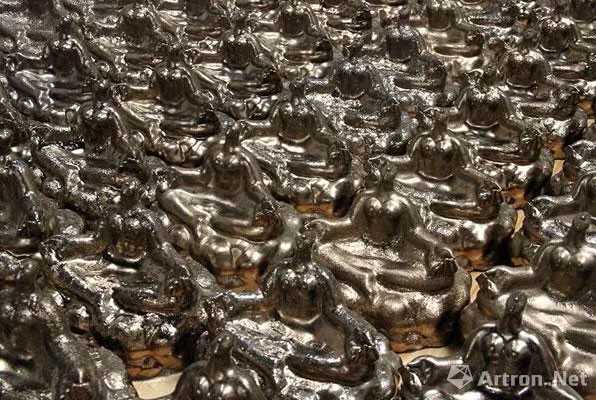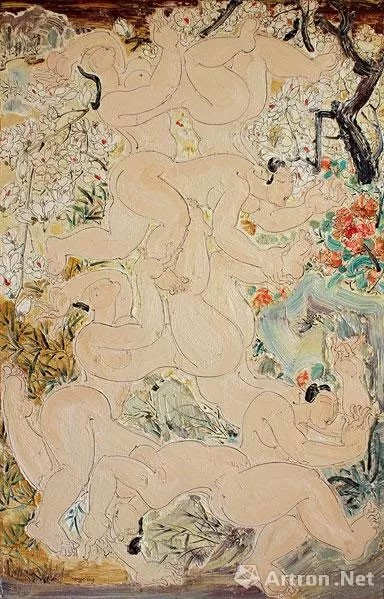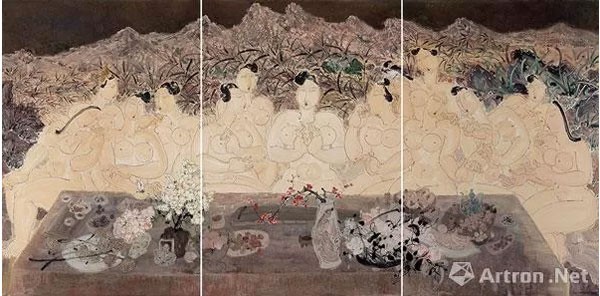As an old saying goes, "Character is destiny." For artists, "character is art." Artists living in the same country and the same era confront the same social environment and material world, yet the way each artist responds to the world and the attitude each artist holds towards life can be different, or even totally different. There are many causes for this phenomenon. Still, the character of artists is indisputably an important factor. According to Modern Chinese Dictionary, character refers to the mental qualities of a person reflected in his attitude and behavior when dealing with other people and things.

Zhao Mengge A Myriad of Living Things Ceramics Installation 2018
In 1905, Fauvism and expressionism emerged in France and Germany respectively at the same time, which are considered as two variants of one style by western art historians. The renowned German art historian Werner Haftmann defined the difference between the two variants as "The French one stresses the form- 'expression' is about 'the form'; the German one emphasizes the subject-the 'form' is about 'expression'." For me, the defining difference between the two is that Fauvism seeks to express sensual pleasure, while expressionism tends to pursue pains of the soul. The difference between the two might as well be attributed to differences of national character, i.e., the divergent artistic tastes arise from the inherent optimistic trait of the Latins and the intrinsic introspective and prudent character of the Teutons. However, there are huge divides even among Fauvism artists regarding their art tendency. For instance, Henri Matisse, a leading figure of Fauvism once said, "What I dream of is an art of balance, purity and serenity, devoid of troubling or depressing subject-matter, an art which could be for every mental worker, the civil servant as well as the man of letters, a soothing, calming influence on the mind, something like a good armchair which provides relaxation from physical fatigue." This remark is deemed as the declaration of Fauvism by later generations, and the art of Matisse becomes the paradigm of this declaration. This is the art ideal that he pursued consistently throughout his life, even in face of German invasion into his homeland. Georges Rouault, whose work is often associated with Fauvism, rejected the declaration of Matisse completely, as Rouault sought to unveil the ugliness of humanity and suffering of the spirit. The different artistic tastes of these two masters originate from their different character undoubtedly. In a sense, the diversity of art originates from the diversity of artists' character, and the personality of art from the uniqueness of artists' character.

Zhao Mengge Great Happiness 2015-2017 212×140cm
Zhao Mengge is an artist who is gentle and resilient, and optimistic and prudent at once, which is reflected in her art.
Zhao once studied at Fine Arts School Affiliated to Central Academy of Fine Arts (CAFA) and No.3 Studio of the Department of Oil Painting, CAFA. Her earlier works demonstrate a typical expressionism bias. Most of those works feature ordinary people living at the bottom of society. The heavy color and strokes communicate a strong melancholy feeling and bitterness, be it dressed portraits or nude men and women. You can tell from them that Zhao shared the compassion that van Gogh demonstrated in his creation. She attempted to work with mixed materials to play with the colors of conceptual arts and the implications of abstract art in her work. However, it did not take long before she gave up these styles and exploration, because expressionism seeks to unleash negative feelings and conceptual art is critical of various established value standards, which is not who she is.

Zhao Mengge Watching The World 2011-2014 212×420cm Oil on Canvas
Since 2005, Zhao has gradually found her own unique painting style, a comprehensive style that integrates the idea of "Chushi" (i.e., rise above the earthly world) in Taoism, Plato's idea of utopia, Mannerism's figure styling and the artistic tastes of Fauvism, or rather, she has created a unique nude female image to build her own art world. The nude female image results from heavy paint with a black contour. Strikingly vibrant and highly decorative, these strong and plump nude female images either show up in her painting alone or as a pair or in groups, seated or in a reclining position. You cannot seem to figure out their origin. They are reminiscent of painting of the Tang Dynasty or those beautiful ladies in tricolor-glazed pottery of the same dynasty. They also call to mind the dimensions and volume of figure drawing of superb modern artist Amedeo Modigliani. What is even more peculiar is that all the nudes under the brush of Zhao seem to be twin sisters with almost identical appearance which reminds us of British painter Dante Gabriel Rossetti, an advocate of Pre-Raphaelite Brotherhood who created different images out of the same model, and Sir Edward Burne Jones who created figures with identical appearance in The Golden Stairs. Apart from that, Zhao always puts her nudes in natural environment, such as mountains and waters, lush grassland and trees or blooming flowers. As we all know, nudes are exotic to traditional Chinese art history, and it is a form particularly popular among the west believing in dualism which puts nature and mankind at opposite ends. Zhao is not a feminist. Nor does she attempt to patronize gender equality or female independence in her painting. Her nude female figures are devoid of any social attributes. They are women in a natural state, or in a biological sense. It should be noted that Zhao exaggerates the facial structure of her nudes intentionally by elongating their noses to such an excessive extent that they are abnormally bended. This typical mannerism tuning subverts the typical appearance of Han people, thus rendering facial features of an alien nation to them. In other words, these female nudes have surpassed the difference of social class and boundaries of nationalities and races, and come to represent pure life without specific social labels.

Zhao Mengge Disciple 2014 75×420cm Oil on Canvas
These female nudes are symbols and carrier of spirit created by Zhao. As time passes by, increasingly richer connotations grow inside them. As these titles indicate, Zhao draws inspirations from a wide range of sources-The Land of Promise and Disciple inspired by the Bible, Watching The World, Form Itself Is Emptiness; Emptiness Itself Is Form and Great Happiness informed by Buddhism, and those inspired by Taoism's idea of "Chushi" and the works of ancient men of letters, such as Deep in The Bamboo, Hermitage and The Hermits . Also, there are a lot of works deriving from everyday life. Meanwhile, she leverages the image appropriation strategy of conceptualism in an attempt to apply western classical patterns to her own creation. For example, the composition of Watching The World is modeled on The Last Supper by Leonardo da Vinci; Harmony borrows from The Graces/Kharites, a subject-matter frequently popping up in western classical painting; Day, Night, Morning and Evening pay homage to a series of famous sculptures created by the renowned Italian Renaissance sculptor Michelangelo. Besides, the posture or gesture of many female nudes under her brush seems to hint at Bodhisattvas sculptures. Born in the countryside of Henan, she involves a lot of elements related to folk art in her creation as well.

Zhao Mengge Rural Times 2014 140×556cm Oil on Canvas
Zhao's painting mirrors a unique phenomenon in the era of globalization, which is breaking away from cultural barriers for the integration of different Chinese and foreign cultural elements both from the past and the present. This cultural stance is in line with "nomadism" proposed by modern French philosophers Gilles Louis René Deleuze and Pierre-Félix Guattari in A Thousand Plateaus. To put it another way, it is a cultural value advocating inclusiveness, divergence, anti-authoritarianism and counter-induction. Zhao could break through temporal and spatial boundaries and transverse freely between Chinese and western art of ancient and modern times. In her painting, you can feel the balance and inclusion of the reality and illusion, reason and passion, symbolism and expressionism, as well as religion and the mundane world. Through appropriation, mixture and reconstruction, she transforms the memory of history and the visions of the ideal world into pieces of tangible visual images, fully showcasing the all-inclusive nomadism.
Apart from the subject-matter of her works, Zhao's art ideas are also palpable in the titles of her solo exhibitions since 2002. "Paradise", "Oriental Garden of Eden", "Dream Maker", "Dream Space ", "Hermitage" and "Utopia " among others tell of her artistic pursuit comprehensively and accurately. This exhibition titled "Aseity" at Shandong Art Museum extends and deepens the titles and their meanings mentioned above. Borrowed from Buddhism, the title expresses Zhao's longing for a free and natural state of being. Instead of being a critic of the ugly reality, she strives to build a surreal utopia; instead of lamenting the harsh life, she commits herself to pursuing a fabulous dream. In essence, Zhao shares a similar art ideal to the "good armchair" of Fauvism master Matisse. If put it in the context of Chinese modern art history, she would strike a chord with Lin Fengmian and Chang Yu. In the era of globalization, Zhao adds the value of a global village to the idea of "Chushi" cherished by ancient Chinese scholars and utopia of ancient western philosophers.
Just like her name, Zhao Mengge is a singer of dreams. When she sings about happiness, she seizes the heart of everyone because happiness is our shared wish.
Beijing, May 22, 2018
Wang Duanting, Researcher of Fine Art Research Institute, Chinese National Academy of Arts
Copyright Reserved 2000-2025 雅昌艺术网 版权所有
增值电信业务经营许可证(粤)B2-20030053广播电视制作经营许可证(粤)字第717号企业法人营业执照
 京公网安备 11011302000792号粤ICP备17056390号-4信息网络传播视听节目许可证1909402号互联网域名注册证书中国互联网举报中心
京公网安备 11011302000792号粤ICP备17056390号-4信息网络传播视听节目许可证1909402号互联网域名注册证书中国互联网举报中心
网络文化经营许可证粤网文[2018]3670-1221号网络出版服务许可证(总)网出证(粤)字第021号出版物经营许可证可信网站验证服务证书2012040503023850号